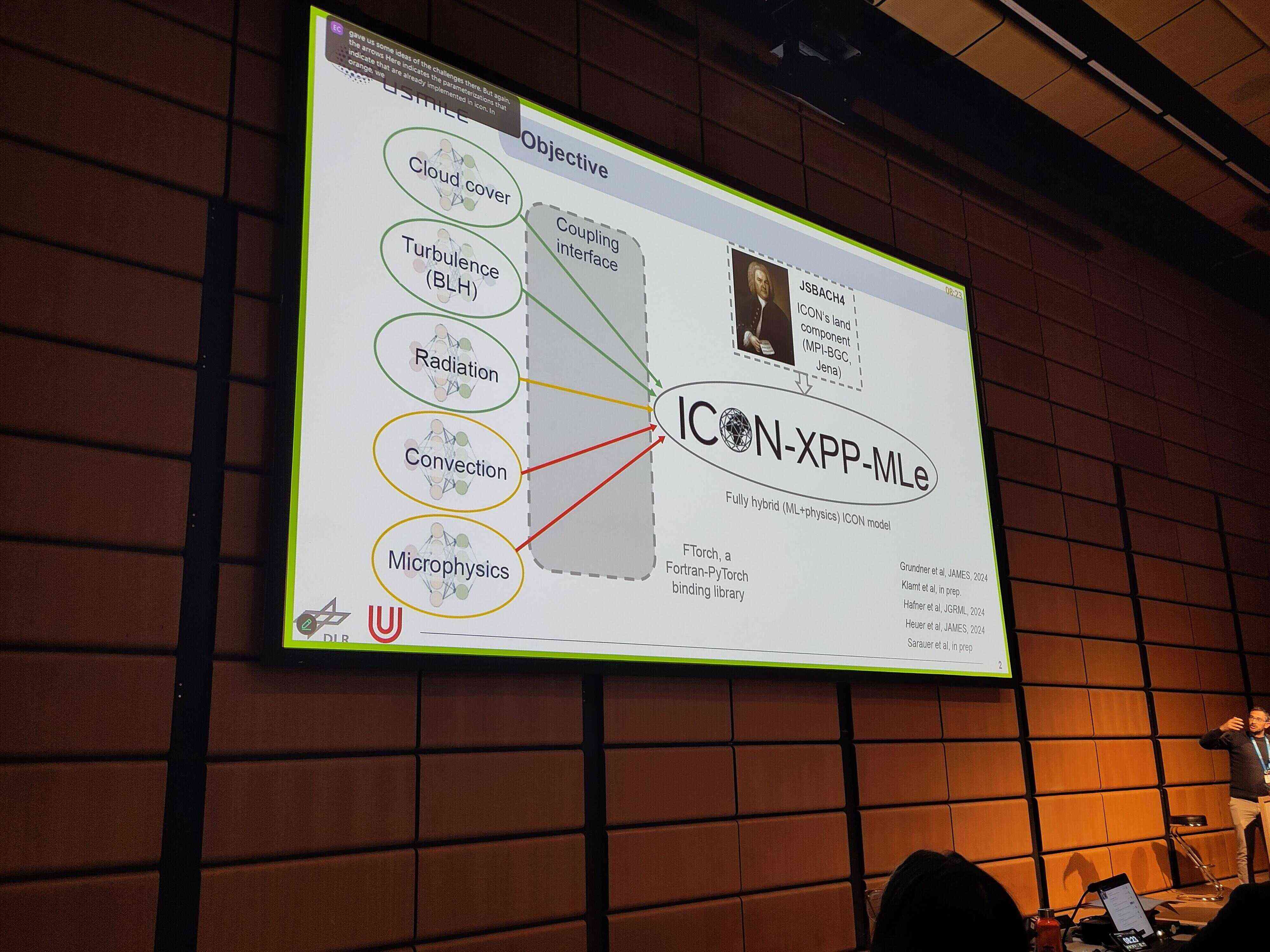Reflections on EGU25
Well that’s a wrap on the European Geosciences Union 2025 (EGU25), the largest meeting for scientists (~21,000) in this domain held annually in Vienna, Austria, Europe. I love attending this event, and here are my thoughts from this year.
Please note that these are my opinions and may not reflect those of my institution, funder, or managers.
Contents

Sunset over the Danube in Vienna
Reflections
The software and computing space continues to grow
The first year I came to EGU as a research software engineer rather than a scientist I couldn’t help but feel a little out of place.
Now we have a double session on the application of FAIR principles in the geosciences, a session on BUGS: Blunders, Unexpected Glitches, and Surprises in code, a double session on use of Pangeo, short courses on Pangeo and programming skills etc. This is great to see, and helps reassure me that a) there is a future for research software engineering in this space (the domain application is important to me in my work) and b) research is caring more and more about these aspects.
I also noted that a significant number of posters and presentations ended with “our tool/code/work is available on GitHub/Lab at this link” which is great to see, and a noticeable change on previous years.
The train gets ever more popular
Avoiding air travel and maximising use of public transport is something I feel strongly about, and I have been a long-term advocate of #Train2EGU. I would point people to Milan Klöwer’s 2019 study of the carbon footprint of this very conference.
I am fortunate that my university/funder supported me in this early on, but we are now seeing a rise in the number of institutions requiring people to travel by train where possible. We love to see it. It was great to see so many poster tubes and familiar faces at the eurostar terminal and find myself just 3 seats away from old colleagues from BAS on the train. However, this does mean that the Deutsche Bahn seat reservations becomes all the more important so you aren’t sat on the floor like I am whilst writing this!!
For those looking to travel to EGU by train I highly recommend using an interrail pass or eurail if a citizen outside of Europe (including UK, cry). This allows easy and cost-effective travel in Europe (especially Germany and Austria) and passage via eurostar with a seat reservation.
Related, Vienna has some great vegetarian and vegan food options .
The attack on American science is felt in Europe
No-one reading this will be unaware of the attacks and gutting of science and education currently taking place in America. This was noticeable at EGU with a significantly higher than normal number of abstracts withdrawn from almost every session I attended, including ours. Perhaps the most distressing moment, however, was seeing colleagues from AGU break down in the middle of their talk about open science.
I hope that Europe can continue to speak up for science and freedom (the irony), support our colleagues, and stand against the regime in the US. Science will never stop, but it can be seriously slowed.
AI Forecasting swings back towards traditional topics/approaches
The last two years saw a lot of “we can do AI forecasting” and “well, we can do better AI forecasting” from big tech. What struck me at EGU25 is that this has now moved on to scientists using AI forecasting models. Much of this work is adopting approaches that we have seen for a long time to evaluate the results of traditional forecasting models. It’s good to see these models outlast the hype and start being used to answer questions.
Differentiable models
I’ve heard it said that ‘agentic’ is the word of 2025, but in the geoscience space I think it will be ‘differentiable models’. Kicking us off last summer was Neural GCM , and it feels to me like this is the breakout topic this year. We are seeing lots of interesting ideas around online whole-loop training in a range of spaces from parameterisation, data assimilation, to model tuning.
This work is still taking place in simplified models (I include NeuralGCM here!) and I feel that there will be a lot of inertia (more than usual) when it comes to operational modelling adopting these ideas. As a result I am making sure that we include it in the discussions at our September workshop on hybrid modelling in Cambridge.
ML has (finally) made it to space weather
For a couple of years I worked at the British Antarctic Survey as a Radiation Belt Scientist. Whilst AI weather prediction was on the rise I noted a lot of resistance from the space weather (especially modelling) community, even though there were great candidates for both hybrid models (data-driven diffusion coefficients) and emulation. Whilst this subject is no longer a focus for me, I do like to touch base every so often to see what’s going on. Things seem to have changed this year with some great posters on ML modelling, and dedicated sessions on the programme.
Highlights
Now for my particular highlights of the week:
- FTorch is being used heavily in the hybrid version of the ICON model by DWD! It was great to see the project I lead at ICCS facilitating the hybrid version of ICON (ICON-XPP-MLe) in Julien Savre-Piou’s talk. The aim of FTorch is to provide a software solution to facilitate science, so it’s great to see that happening.
- Lauren Snyder (TIB)’s talk on Escaping from the 1600s and the ORKG-reborn project . This work is very similar to what I hope to do with my 2025 SSI fellowship . We had an excellent discussion and I look forward to helping expand this work.
- In the session that I convened with Laura Mansfield (Oxford) and Will Chapman (NCAR) on
Advancing Earth System Models using Machine Learning
:
- Tom Beucler (Lausanne)’s talk on Distilling Machine Learning’s Added Value plotting (offline) performance and complexity of both physics-based and ML parameterisations together to get a picture of how and where they are useful. We had a good discussion after, and I look forward to seeing the ‘online’ version of this work.
- Helena Reid (UKMO)’s talk on stochastic parameterisation , and the idea of perturbing the inputs to the schemes to represent inhomogeneities within a grid cell.
- Maximilian Gelbrecht (TUM)’s talk on Differentiable Programming for Atmospheric Models using speedy . He claims that we need a new generation of models, but fromt he same talk I wonder where we could get to using Enzyme in Fortran at the LLVM intermediate representation level?
- Kai Keller (BSC)’s talk on Replicability in Earth System Models , how things can change between running on different machines, whether runs can be regarded as a single ensemble and the implications for science.
- The argument for domain specific data repositories to actually make data FAIR. “Zenodo is where data goes to die”, but curation by domain experts in a domain space makes it more FAIR in reality. This resonates with my beliefs about the importance of domain knowledge in software and data that I spoke about at RSECon last year .
- Regridding leading to Moiré patterns in model data showing the importance of selecting appropriate algorithms for your data, and that software considerations are key at all levels of work, not just modelling.
- GeoGPT (honourable mention). In general I am not wild about LLM hype. However, I find training one specifically for the domain to be an interesting idea.

FTorch in hybrid ICON
Predictions
Finally, I thought I would make a few predictions about the coming year. Hopefully I can see how well they are borne out at EGU26:
- It will be a big year for differentiable modelling. I already said this above, but will add that we have ongoing work to bring autograd functionality into FTorch.
- Next year will have more open-source tooling being presented. I noted how there is a growing space for RSE, and that more projects were “proudly open-source” this year. Whilst this is good, only a limited amount struck me as “useful and reuseable”. I expect/hope that will have changed in a year’s time.
- Climate emulators will catch up with NWP emulators. For a while Climate has lagged behind NWP in emulation, but I think this is changing. Hot off the press is Will Chapman et al’s CAMulator , and I expect there to be more over the coming year. Perhaps they will even get to the ‘doing useful science’ stage that I noted AI forecasting seems to have reached.
- EGU26 will have a stronger US presence. Whilst public services and federal funding will suffer, I hope US research will continue, and expect Europe to become a desirable forum to share results (and look for jobs) in.